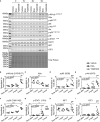Disruption of endosomal trafficking with EGA alters TLR9 cytokine response in human plasmacytoid dendritic cells
- PMID: 37020542
- PMCID: PMC10067882
- DOI: 10.3389/fimmu.2023.1144127
Disruption of endosomal trafficking with EGA alters TLR9 cytokine response in human plasmacytoid dendritic cells
Abstract
Plasmacytoid dendritic cells (pDCs) exhibit bifurcated cytokine responses to TLR9 agonists, an IRF7-mediated type 1 IFN response or a pro-inflammatory cytokine response via the activation of NF-κB. This bifurcated response has been hypothesized to result from either distinct signaling endosomes or endo-lysosomal trafficking delay of TLR9 agonists allowing for autocrine signaling to affect outcomes. Utilizing the late endosome trafficking inhibitor, EGA, we assessed the bifurcated cytokine responses of pDCs to TLR9 stimulation. EGA treatment of pDCs diminished both IFNα and pro-inflammatory cytokine expression induced by CpG DNAs (D- and K-type), CpG-DNAs complexed with DOTAP, and genomic DNAs complexed with LL37. Mechanistically, EGA suppressed phosphorylation of IKKα/β, STAT1, Akt, and p38, and decreased colocalization of CpG oligodeoxynucleotides with LAMP+ endo-lysosomes. EGA also diminished type 1 IFN expression by pDCs from systemic lupus erythematosus patients. Therefore, our findings help understand mechanisms for the bifurcated cytokine responses by pDCs and support future examination of the potential benefit of EGA in treating type 1 IFN-associated inflammatory diseases in the future.
Keywords: EGA; endosomal trafficking; nucleic acid; plasmacytoid dendritic cells; pro-inflammatory cytokine; toll-like receptor 9; type 1 interferon.
Copyright © 2023 Wiest, Gu, Ham, Gorvel, Keddis, Griffing, Joo, Gorvel, Billadeau and Oh.
Conflict of interest statement
The authors declare that the research was conducted in the absence of any commercial or financial relationships that could be construed as a potential conflict of interest.
Figures







References
Publication types
MeSH terms
Substances
LinkOut - more resources
Full Text Sources
Research Materials
Miscellaneous

